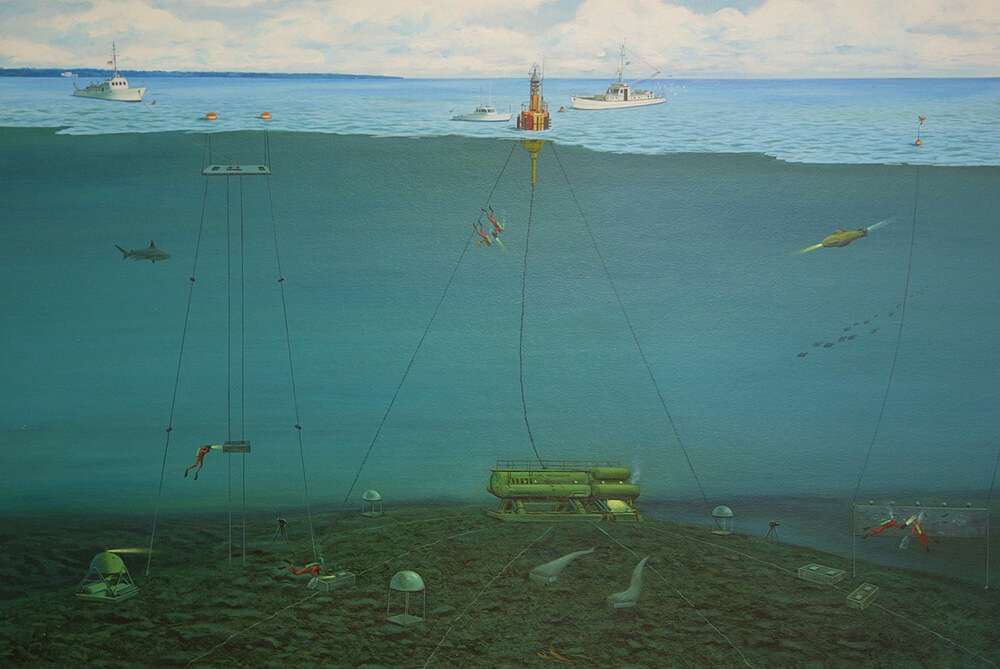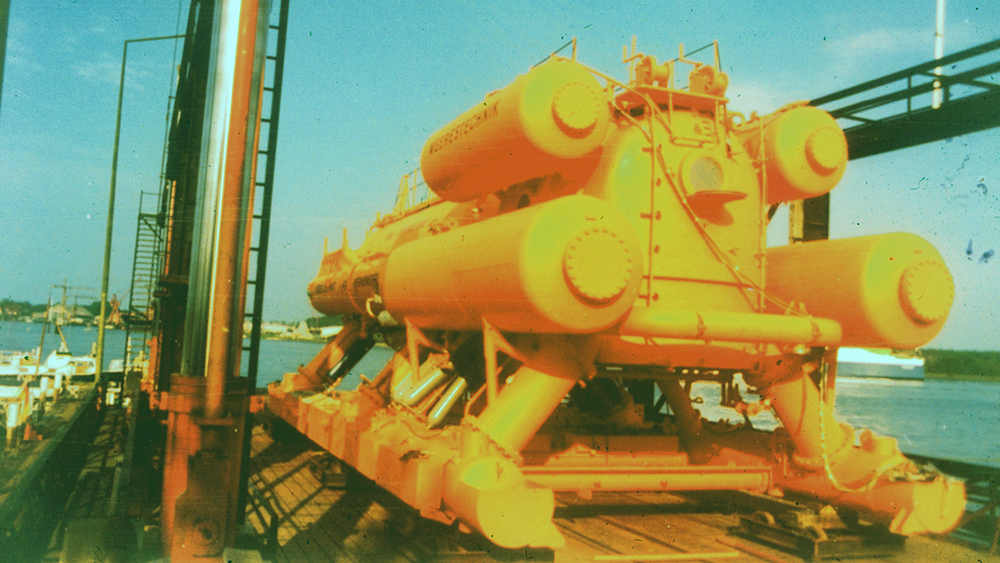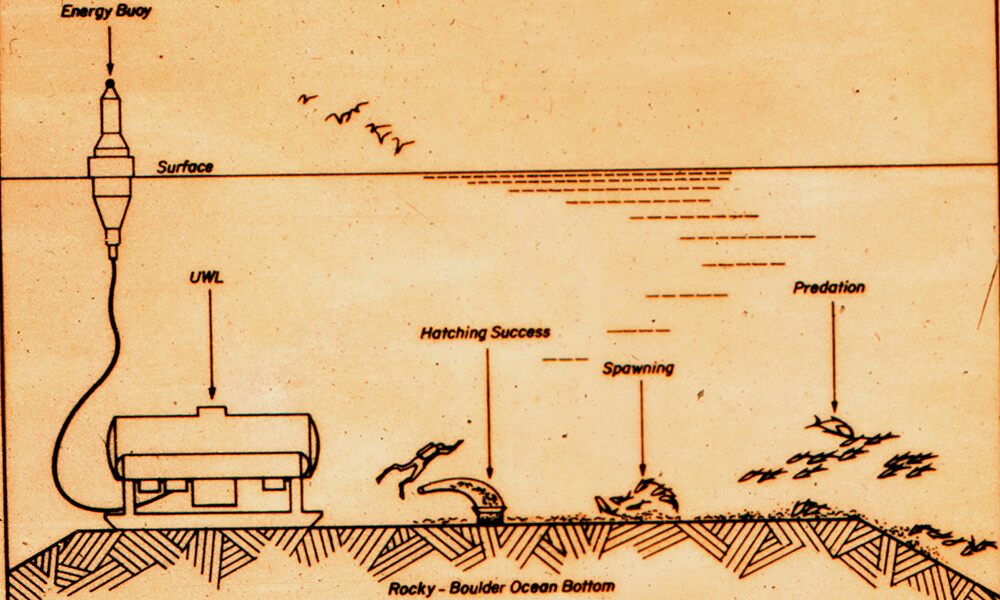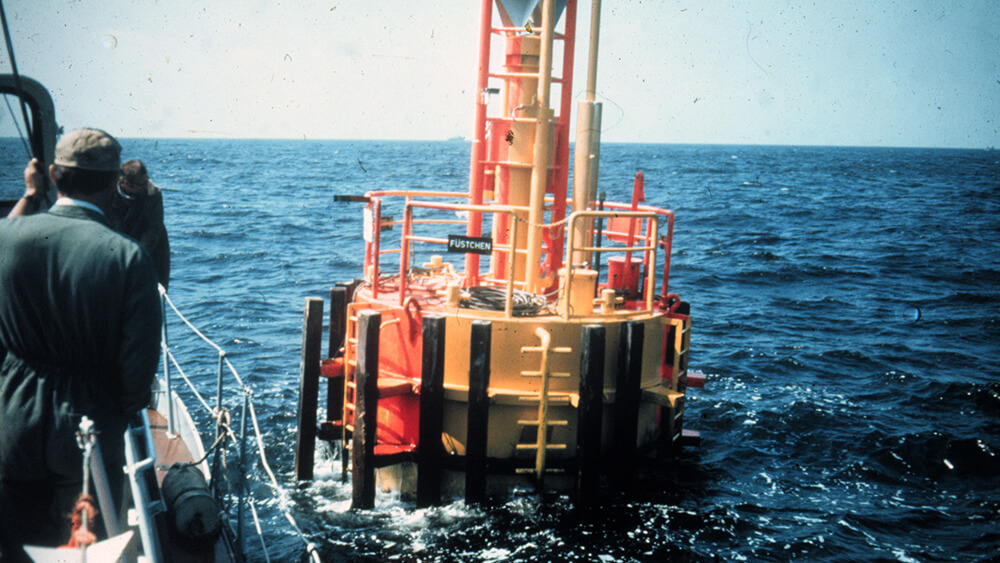Helgoland Underwater Habitat

Helgoland Mission to the Seafloor (adapted from an article in Stellwagen Banknotes, Spring/Summer 2011)
In 1975, in the early years of the man-in-the-sea program when divers and scientists were pushing the boundaries of the inner-space frontier, an underwater habitat was placed on Jeffreys Ledge for three months. Although only a short-term experiment in underwater living, evidence of the project still remains on the sanctuary seafloor – the name associated with the operation is "Helgoland."
In 2011, the sanctuary dive team, looking to expand their explorations beyond Stellwagen Bank to Jeffreys Ledge, decided to search for the Helgoland site. Luckily, within 50 feet of the estimated coordinates the divers found an anchor chain. Upon following the anchor chain, they discovered two large Danforth anchors used to secure the habitat's surface support buoy.
Helgoland was (and still is) an ungainly structure – a bright orange-yellow mix of tubes, tunnels, and tanks sitting 115 feet beneath the water's surface. This massive metal invention of German engineering had seen service in the North and Baltic seas. In September of 1975 it came to the United States for a three-month mission dedicated to fisheries biology through NOAA's Manned Undersea Science and Technology Program. From September until November, a multinational team (U.S., Germany, Poland, and Soviet Union) experienced challenges from severe storms and a hurricane to uncooperative study subjects (herring), but their experiences added to the growing body of knowledge about saturation diving and the use of underwater habitats.

The Helgoland habitat measured 14 meters (46 feet) long, seven meters (23 feet) wide, and seven meters (23 feet) high. Four-person dive teams spent week-long rotations in its damp, cramped spaces, which included a kitchen/dining area, bunks, and laboratory space in the central compartment. A "moon pool" and "suiting up" area with access to the ocean were located at one end, and the decompression chamber at the other.
The main feature that made this underwater structure habitable is that the pressure inside the facility is equal to the pressure at depth. Divers were able to enter and exit the habitat through the downward facing moon pool (a two-meter wide hatch). Once inside Helgoland, drysuits (preferable to wetsuits due to cold water temperatures) could be removed and normal clothing worn for non-dive operations. Life inside Helgoland was not without danger. If the air pressure inside were to drop precipitously, water could rush in and flood the living spaces.
As part of the Helgoland mission, all divers had to be experienced in saturation diving, a relatively new technique at that time, which allows humans to work for long periods of time at depth. In traditional diving, the deeper a diver goes below 33 feet, the shorter the allowable dive time. At deeper depths, there is more pressure, and the gases breathed into the body are compressed (and enter the bloodstream that way). While surfacing from a dive, compressed gasses, such as Nitrogen, are released from tissue compartments within the body as the diver breathes out.Divers who surface too quickly without properly off-gassing risk suffering a condition called decompression sickness or "the bends." In most dives, decompression time is based on depth and length of dive time.

In saturation diving, it was found that there is a certain point in time during a deep dive (and habitat stay) where the body's tissues get filled to capacity with the pressurized gasses. After a stay of at least one day, divers only need to decompress once -- although that session can be quite lengthy. The decompression period in Helgoland's decompression chamber was 50 hours. When fully decompressed, the divers would quickly be returned to the 115-foot pressure ( equal to the depth outside), don their drysuits, and exit the habitat as if they were undertaking a traditional dive. The final ascent back to the surface required a normal, short decompression stop at 10 feet before surfacing.
Fisheries scientists selected the Helgoland site as they thought it was a prime spawning area for herring, an important prey for many commercial fish. The research objective was to get a better understanding of predation on herring eggs, in order to develop ways of protecting those eggs and prevent further population decline. The scientists also sought to identify distinctive acoustic signatures or sounds made by specific groundfish species. One possible application of these research goals might have been to develop more selective fishing techniques that minimize bycatch. The science project was entitled the "First International Saturation Study of Herring and Hydroacoustics" or FISSHH.

Unfortunately for the Helgoland team, Murphy's Law – "If something can go wrong, it will!" was in effect. The projected herring spawning did not happen at the chosen location during the fall, although herring did spawn nearby in the Gulf of Maine. The secondary mission of detecting and identifying fish through acoustics also failed due to flooded electronic equipment.
Conditions were unfavorable due to a series of storms and the outer edges of a hurricane, the naturally cold bottom water of the Gulf of Maine, the distance from shore, the depth of the habitat, and the unsheltered nature of the location (sitting out on a rocky ledge). Heavy seas were probably a factor in the most tragic aspect of the mission – the death of one of the German divers during ascent from the habitat. It is believed that large swells may have swept him to the surface during his decompression stop.
The mission scientists reported that although they did not accomplish their original research goals, they did learn a lot about techniques for conducting science in cold water. They also added to existing knowledge of saturation diving, and furthered the cause of benthic biological studies.
The Helgoland underwater habitat now resides on land at the Nautineum of the German Oceanographic Museum in Stralsund, Germany.
Read the full article in Stellwagen Banknotes, Spring/Summer 2011.

